Power Generation with Renewable Energies - PGRE - Solutions

Alternative Energy - What is it and why?
From the academy there is no consensus on the definition of what an alternative energy source is, so we find two types of definitions, the most restrictive definition and the broadest definition, let's see what each one says:
The restrictive definition tells us that alternative energy sources are those that come from virtually inexhaustible and 100% renewable natural resources, such sources would be the sun, wind, bodies of water and the internal temperature of the earth. This type of energy is also known as green or renewable energy. Green because its production does not involve the problems associated with pollution or the generation of greenhouse gases.
While the broad definition indicates that alternative energy sources are all those that do not involve the burning of fossil fuels such as coal, gas and oil. Within this concept, we include as sources those mentioned in the restrictive definition, as well as nuclear and hydrogen energy.
From these definitions, we can see that the consumption of fossil fuels is the problem, because it creates pollution that the affects the quality of life, and the extraction of this material is very invasive, destroying the environment and the produce negative impact on the climate.
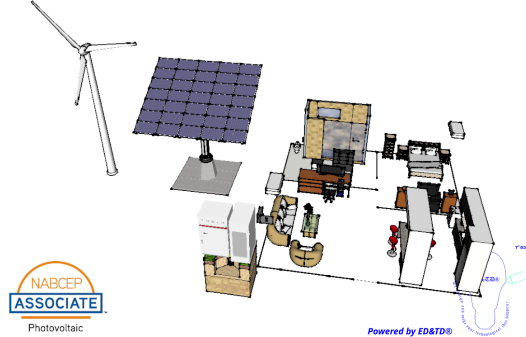
In this context, Electronic Design and Technological Development - ED&TD®, knowing that since time immemorial the main sources of energy have been renewable, such as wind, sun, sea waves, temperature, among others, we have been motivated to design and implement energy solutions that respond to the Earth's call to ensure its sustainability, and taking into account the international commitment to reduce damage to the environment and for our customers and/or partners to reduce their carbon, ecological and environmental footprint, we have focused on formulating energy sustainability projects energy that implement 100% green or renewable energy.
Before we tell you about our solutions in this area, first you need to know what the energy sources are and How does Electronic Design and Technological Development - ED&TD® approach them in engineering design?
After reading what and how you can understand our proposal read more! …
We can provide to you all engineering that you requeire to make your idea(s), only contact us now!...
What are the sources?
With this approach, the alternative energy solutions that we design, develop and implement take as sources the following:
- Solar Energy - Harness the power of the sun read more …
- Wind Energy - Harness the power of the wind read more …
- Geothermal Energy - Harness of the Earth's heat read more …
- Wave and Tide Energy - Harness the mechanical energy generated by the movement of the waves read more …
- River Energy - Harness the kinetic energy of flowing water read more …

Solar Energy
It is the virtually inexhaustible and renewable source of energy that has been available to mankind since the beginning of time.
When we refer to the Sun as a source of energy, we are referring to its structure, which, like other stars, is a ball of gas that can reach temperatures of 27 million degrees Fahrenheit (15 million degrees Celsius) at its center, enough to sustain thermonuclear fusion. This is the very source of energy that keeps the Sun alive and produces all the heat and light that emanates from it.
This energy is now transported outward by radiation.
As we mentioned at the beginning, this source is virtually inexhaustible and renewable because, as the following quote says
"Kazakhstan has assured that the sun will last for another 1 billion years. This was known thanks to the support of the Fesenkov Institute of Astrophysics, which in 2016 carried out the first study on the Whole Earth Telescope (WET) project." (taken from URL: https://www.elpopular.pe/actualidad-y-policiales/2016-02-09-ciencia-expertos-revelan-el-tiempo-de-vida-del-sol-y-no-lo-creeras el 2017- 11-12 at 10:53 LMT.)
We then observe that it is a source of energy that will not be exhausted for the immediate moment.
We can quantify the energy of the sun through the radiation at any point on the surface of the Earth, and for this we use the solar radiation maps published by each Institute of Hydrology, Meteorology and Environmental Studies and/or its equivalent in each country.
- Ministry of Energy and Infrastructure on Israel
- National Oceanic and Atmospheric Administration - NOAA on United State
- National Renewable Energy Laboratory (NREL) - Solar Resource Data, Tools, and Maps on United State
- Radioactivity Environmental Monitoring - REMon on Eurpoan Commission
- Institute of Hydrology, Meteorology and Environmental Studies - IDEAM on Colombia
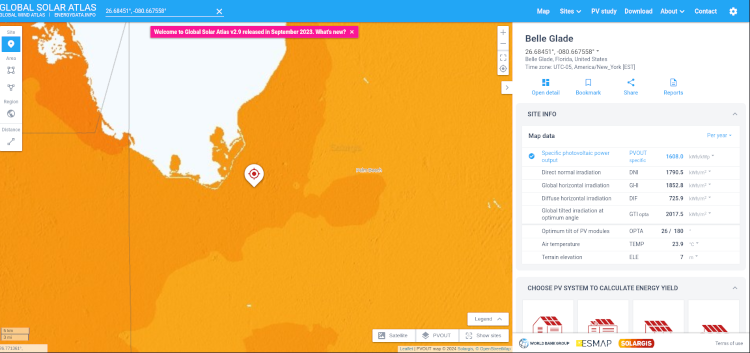
In these maps we will find, among other things, the following data, namely
- Irradiance expressed in KWh/m2
- Hourly average irradiance expressed in Wh/m2 per time zone
- Among many other data necessary for sizing the photovoltaic system needed to supply the loads to be connected …
Wind Energy
It is the second source of alternative energy, which, like the first one, is practically inexhaustible and renewable. In this form of energy we take advantage of the kinetic energy of air currents.
The first thing we need to know is how these currents, also called winds, are formed, and they are the result of the mass movement of air in the atmosphere in horizontal motion.
It is necessary to remember that thanks to the Sun, when the rays of this star reach the Earth, they heat the air and it expands, that is to say, it is less dense and consequently tends to rise to be replaced by air coming from the surrounding areas, which by definition is colder.
Thanks to the sun and other physical phenomena present in nature, which guarantee the continuous and permanent existence of air currents, we observe that this is a source of energy that is not exhausted for the immediate moment.
We can now quantify the kinetic energy of these air currents at any point on the Earth's surface, using the wind maps published by the Institute of Hydrology, Meteorology and Environmental Studies and/or its equivalent in each country.
- Ministry of Energy and Infrastructure on Israel
- National Oceanic and Atmospheric Administration - NOAA on United State
- National Renewable Energy Laboratory (NREL) - Wind Resource Data, Tools, and Maps on United State
- Radioactivity Environmental Monitoring - REMon on Eurpoan Commission
- Institute of Hydrology, Meteorology and Environmental Studies - IDEAM on Colombia
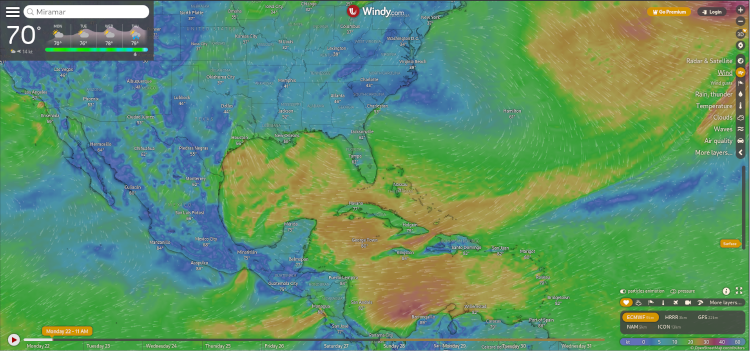
In these maps we will find, among other things, the following data, namely
- Average wind speed expressed in m/s at different heights
- Maximum energy wind speed expressed in m/s at different heights
- Among many other data necessary for sizing the wind turbine needed to supply the loads to be connected …
Geothermal Energy
It is the third source of alternative energy, which, like the first two, is virtually inexhaustible and renewable. This form of energy harnesses the heat generated by the high temperatures of the earth's interior.
The term geothermal comes from the Greek words geo (earth) and thermos (heat); literally, the heat of the earth. We know that the Earth's interior is hot, thanks to the heat emanating from the planet's core, and that the temperature increases with depth.
As we go deeper, we find phreatic layers, also known as aquifers, where the water is literally boiling. This water rises through conduits to the surface of the planet where it manifests itself as a geyser or thermal spring.
There are three types of geothermal reservoirs, namely
- Hot water: These are deposits that can be a spring or underground, contained in an aquifer. Those that form in springs are those used in thermal baths and are not conducive to generating electrical energy through transformation. On the other hand, aquifers located at shallow or medium depth are used for the generation of electrical energy.
- Dry: They are called dry because they are materials such as rocks and/or other sediments that are at high temperatures and, like aquifers, are used to generate electrical energy.
- Geysers: These are thermal springs that periodically emit a column of hot water and steam. They are not used for electrical power generation.
Of these three types of reservoirs, we use only two: aquifers and dry reservoirs.
So, thanks to the internal temperature that comes from the core of our Earth, we observe that this is a source of energy that will not be exhausted for the immediate moment.
Now we can quantify the internal heat of the Earth at any point from the geothermal gradient, using the geothermal gradient maps published by each Geological Institute and/or its equivalent in each country
- Ministry of Energy and Infrastructure on Israel
- U.S. Department of Energy’s on United State
- National Renewable Energy Laboratory (NREL) - Geothermal Resource Data, Tools, and Maps on United State
- Radioactivity Environmental Monitoring - REMon on Eurpoan Commission
- The Colombian Geological Survey (Servicio Geologico Colombiano - SGC) - INGEOMINAS on Colombia
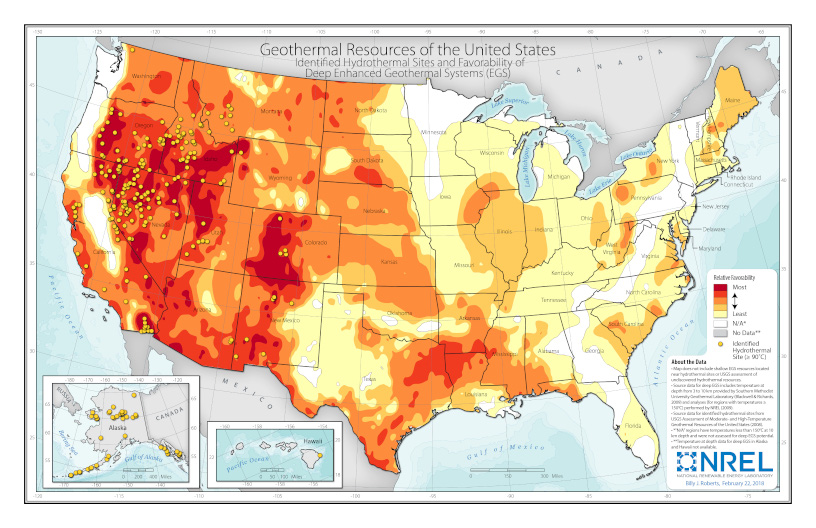
In these maps we will find, among other things, the following data, namely
- Minimum slope expressed in ℃/Km
- Maximum gradient in ℃/Km
- Average gradient in ℃/Km
- Depth range of temperature measurement expressed in m
- Among many other data necessary for sizing the geothermal system needed to supply the loads to be connected …
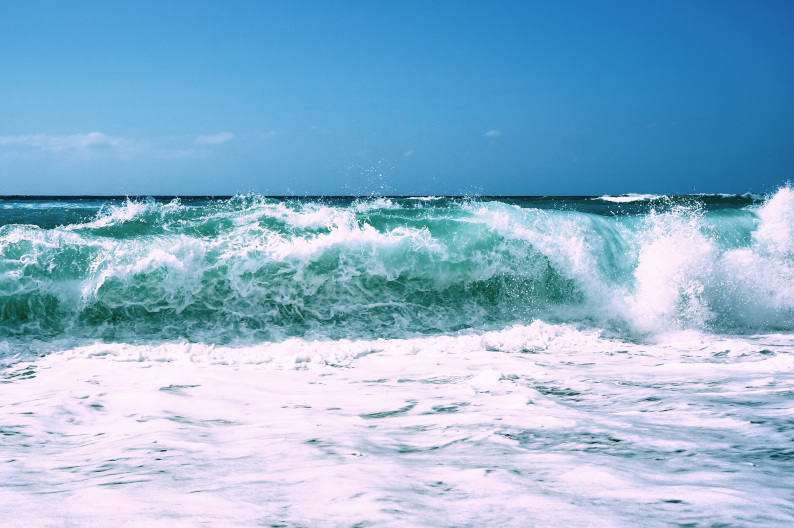
Wave and Tide Energy
It is the fourth source of alternative energy, which, like the first three, is virtually inexhaustible and renewable. In this form of energy, we use the mechanical energy associated with waves, rather than their kinetic energy.
This type of energy is part of the so-called ocean energy or marine energy, which is divided into tidal energy, which takes advantage of the energy associated with the tides, and wave energy. We will first review the concept associated with tides to get into the topic of waves.
We tend to confuse tides with waves without realizing that they are physical phenomena and independent of each other.
The tide is a periodic movement of ocean water caused by the gravitational pull of the Sun and Moon on the Earth (mainly the Moon), and we see it in a rise and fall of the water level.
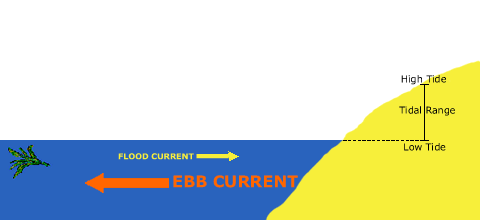
This animation shows the relationship between the vertical and horizontal components of tides. As the tide rises, water moves toward the shore. This is called a flood current. As the tide recedes, the waters move away from the shore. This is called an ebb current. The movement of water toward and away from the shore is illustrated by the movement of the green seaweed. Credit: https://oceanservice.noaa.gov/education/tutorial_tides/tides01_intro.html
If you look closely at the movement, there is a horizontal displacement of water called tidal currents.
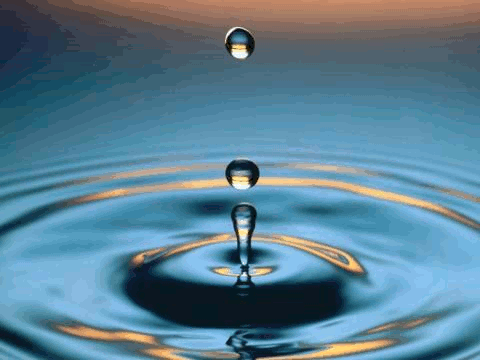
While the wave is the wave motion of water, you will remember the object that falls into a pond with water, waves are generated from the point where the object touches the water, these waves go from the inside out concentrically in all directions. In the case of the sea, the object that generates these waves is the wind that, when it collides with the surfaces of the oceans and/or seas, generates these waves that propagate until they reach the coasts and are formed because the water particles, being driven by the wind, they behave like the waves of the pond that, when they reach the coast, friction occurs with the bottom, deforming their circular movement and increasing the height of the waves until the top falls and the wave breaks on the coast.
You must remember that just as in the example of the pond with water; the water never moved, in the sea, the mass of water never moves, while the wave motion generated by the collision does. That is why we talk about mechanical energy instead of kinetic energy in wave energy sources.
This type of energy can be used in sea areas with depths in the range of [40, 100] m, because only in these areas we find ideal conditions in terms of the period of wave oscillation and the square of its width.
Depending on the depth we find devices:
- On-shore: These are devices supported on the coast.
- Near shore: Devices located in shallow waters [10, 40] m.
- Off-shore: These are floating or submerged devices in deep water [50, 100] m.
Thanks to the wind, we can say that this is a source of energy that will not be exhausted for the immediate moment.
Now we can quantify the wave conditions in each point of the coastal zone, using the wave models published by each Oceanographic and Meteorological Institute and/or its equivalent in each country.
- Ministry of Energy and Infrastructure on Israel
- National Oceanic and Atmospheric Administration - NOAA on United State
- National Renewable Energy Laboratory (NREL) - Water Research / Resource Data, Tools, and Maps on United State
- Radioactivity Environmental Monitoring - REMon on Eurpoan Commission
- Dirección General Marítima - CIOH on Colombia
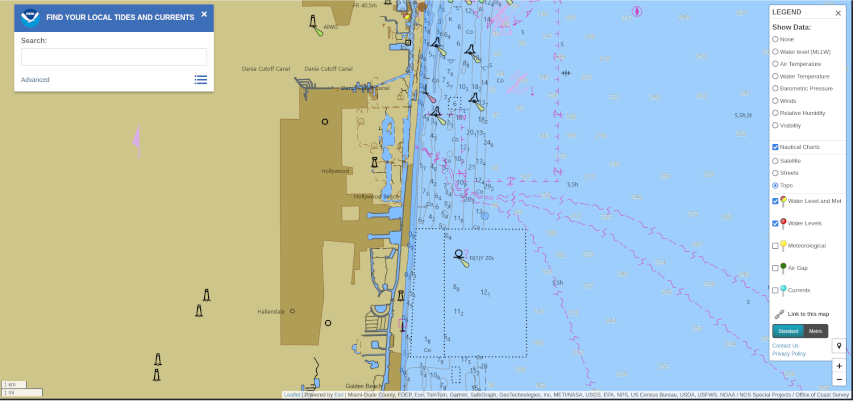
In these models we will find, among other things, the following data, namely
- Wave height expressed in meters
- Wind speed, expressed in knots
- Among many other data necessary for sizing the type of device needed to supply the loads to be connected …
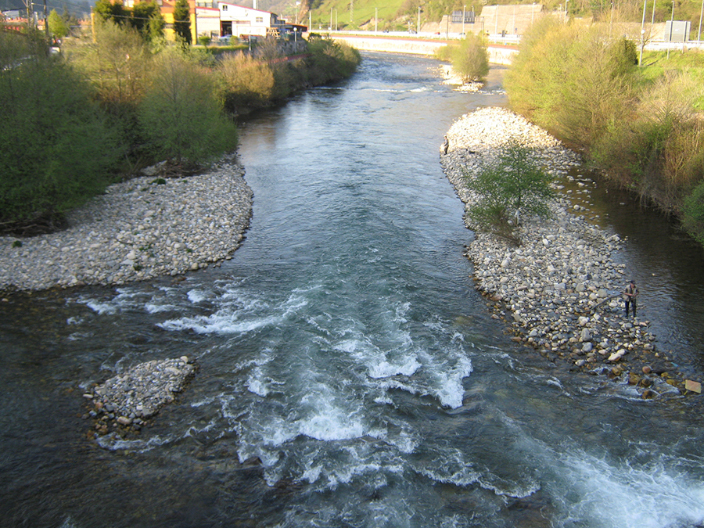
River Energy
The flow of any moving body of water, defined as the amount of water that passes through a given point in a given time, has associated kinetic energy that we use to generate electrical energy.
The flow of these bodies of water is subject to the river feeding regime, which can be: glacial, pluvial, nival, nival of transition, nivopluvial, pluvialival and pluvial with more than one rainy season.
The runoff regime defines the floods and low flows and therefore the absolute characteristics of the flow of a given water body. From these characteristics of a flow we then have river-type surface water bodies such as Regular, Irregular, Permanent, Seasonal, Sporadic, Autochthonous and Allochthonous.
Since this type of energy depends directly on floods and low water levels, it is not considered virtually inexhaustible, and given the deforestation processes associated with water basins, we cannot guarantee that it is 100% renewable.
Now, the flow conditions of the body of water under study can be quantified from the hydrological models and climatological maps published by each Institute of Hydrology, Meteorology and Environmental Studies and/or its equivalent in each country.
- Ministry of Energy and Infrastructure on Israel
- National Oceanic and Atmospheric Administration - NOAA on United State
- National Renewable Energy Laboratory (NREL) - Wind Resource Data, Tools, and Maps on United State
- Radioactivity Environmental Monitoring - REMon on Eurpoan Commission
- Institute of Hydrology, Meteorology and Environmental Studies - IDEAM on Colombia
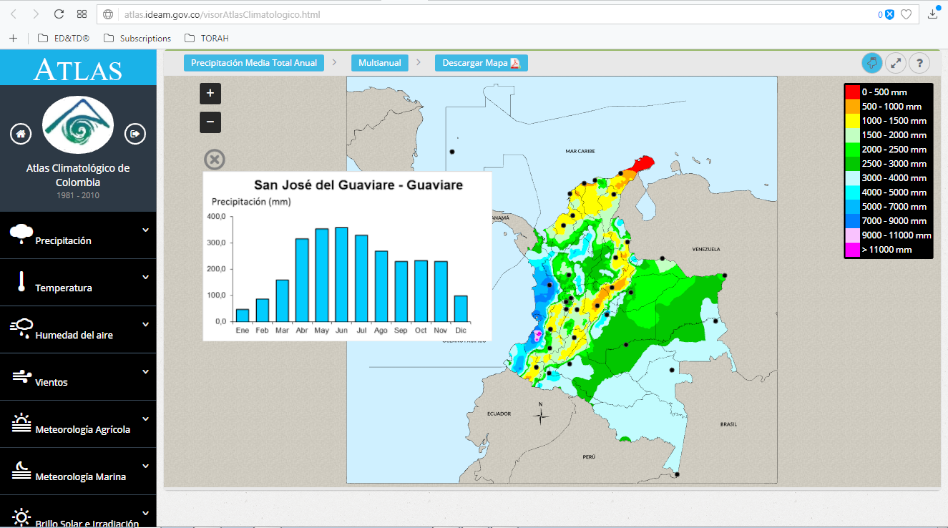
In these models and maps we will find, among other things, the following data, namely
- River discharge regime expressed in mm per period
- Type of river feeding
- The flow rate of the waters that make up the basin, expressed in liters or cubic meters per second (l/s or m3/s). Water level
- Sediment load
- Among many other data necessary for sizing the run-of-river plant needed to supply the loads to be connected …

How does Electronic Design and Technological Development - ED&TD® approach them in engineering design?
A serious implementation project, based on an adequate engineering study, includes the following elements, namely
- Alternative energy source(s) analysis read more …
- Electrical analysis read more …
- Implementation of the project read more …
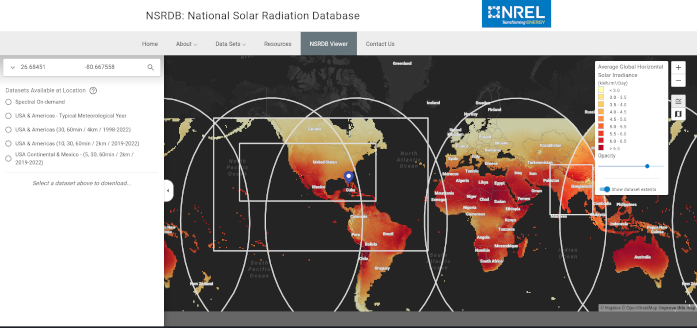
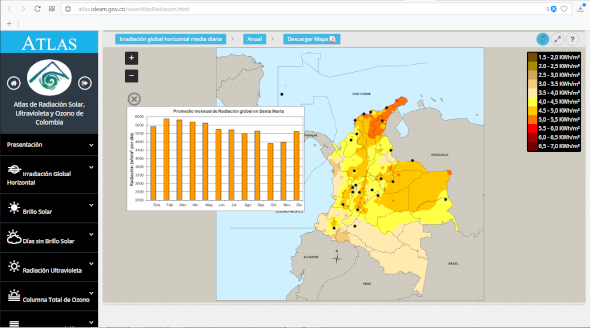
Alternative energy source(s) analysis
As we learned in the Source Energy chapter above, there are radiation maps, wind maps, geothermal gradient maps, wave models, hydrological models, and climatological maps, that are our main resources.
If you choose to meet your energy needs with alternative energy sources, we will first perform a special site characterization; we will determine radiation levels, rainfall, river flow, tides and waves, wind, and geothermal conditions at the site.
We find these variables on the maps and in the models mentioned above. With these values, we will design the correct power supply that can be:
- PV System
- WG System
- GT System
- WT System
- RF System
The analysis also defines:
- If the solution requires an N+1 configuration.
- If it is an off-grid solution.
- If Net Metering is applied.
How does ED&TD® approach them in engineering design?
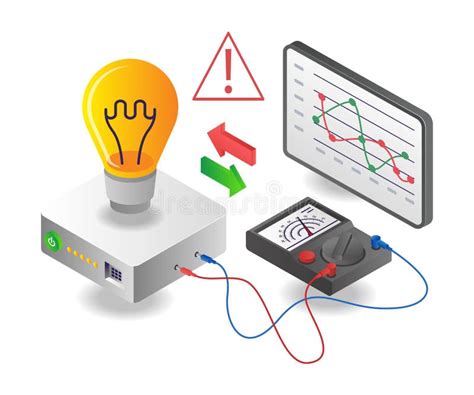
Electrical analysis
It is the process by which information is obtained regarding
- Total loads by load type that the solution must power.
- Technical specifications in terms of voltage, current and power of each load.
- Frequency and duration of use of each load.
- The cost of the KWh/month reported on the corresponding energy bill.
- The usage histogram reported on the corresponding energy bill.
Why is this information needed?
Unlike conventional energy, which by definition is sized by the demand factor, defined as the relationship between the maximum demand of a facility or part of a facility and the total load connected to the facility or part of the facility under consideration, in a PGRE solution we do not apply the concept of the demand factor illustrated above.
What it all means … The demand factor is a probabilistic indicator whose purpose is to predict what loads can be connected to the different electrical access points of a residential, commercial, hospital, industrial, etc. electrical installation. Therefore, in some installations, when many loads are connected to the branches of the installation and they exceed the demand factor calculated for them, the electrical installation presents ups and downs of electrical power, which we commonly call watts.
The way to solve this high and low is to ask your power company to increase the load (watts).
This has some advantages and some disadvantages, the advantages are obvious, I do not need to know what the loads are when I dimension the electrical system, we only repair what the technical regulations of the country say in terms of what the demand factor is for the type of installation I am dimensioning. But, the disadvantages, we do not see them directly, but we feel them economically, why?
The KWh/month rate, which is the multiplication factor used by your utility to monetize your consumption expressed in $/KWh/month, has the following values associated with it within the rate component, namely
- The cost of purchasing or producing energy, expressed in $/KWh.
- Cost per use of the national electric transmission system, expressed in $/KWh.
- Cost per use of the distribution system, expressed in $/KWh.
- Marketing margin, expressed in $/KWh.
- Cost of purchasing, transporting and reducing energy losses, expressed in $/KWh.
- Cost of curtailment, expressed in $/KWh.
- Base marketing cost, expressed in $/Bill.
These values vary from month to month, they are not constant, and depending on your usage, this is the amount you pay for the service. But beyond this information, it is worth noting that the cost per KWh/month is not constant, and in any case we support the operation of our supplier based on the KWh/month.
Now, if we consider that our consumption habits are anything but conscious of saving, let me explain; how many times have we left the TV on, a light bulb, an appliance, whatever it may be? The average consumption also changes from month to month, if this is the second multiplication factor expressed in KWh month, well, we cannot complain about the energy bill.
We observe how the demand factor works in conventional energy and how, based on the cost of KWh/month and consumption habits, we influence the price of the energy service we consume.
As we mentioned, in a PGRE solution we do not apply the demand factor, so what do we apply?
Well, the first thing you should know is what we do with the information we collect in the electrical analysis, with this data we define:
- Consumption habits.
- Plan to change the consumption habits.
- The cost-benefit analysis of the PGRE solution compared to the continued use of conventional energy.
- Regime of monthly energy surpluses that will be injected into the National Electrical System of the corresponding country.
If you notice, at no time we are talking about a demand factor, but we are talking about the improvement of consumption habits that will allow us to define something known as energy surpluses.
In a PGRE solution, we are not buyers of energy, on the contrary, we are producers of energy, and since we are implementing changes in consumption habits, unlike the demand factor, we will have a surplus that we can inject into the National Electricity System and therefore the conventional energy suppliers will have to pay us.
So what is the difference with a PGRE solution? Well, we can see the difference in the following comparison table
| Comparison Factor | Conventional Energy | PGRE Solution |
|---|---|---|
| KWh/month | Varies from month to month | Does not exist |
| Values associated with the rate component |
|
|
| Consumption habits | There is no awareness of saving | Awareness of saving exists |
| Type of user | We are consumers who pay for the energy we use | We are producers, selling the energy we do not use (surplus) |
You can see why electrical analysis is so important in a PGRE project.
How does ED&TD® approach them in engineering design?

Implementation of the project
It is the process by which we design, develop, and implement the PGRE solution and includes
1. Collecting energy usage data and building the load table: We do this through an online form called the "PGRE Site Survey" where we collect the following information
- Contact information
- Description of where the project will be developed
- Dwelling information
- Consumption data
2. Electrical Analysis: Using the data collected in the Alternative Energy Project Form as input, we define
- Electrical design
- CC electrical design
- AC electrical design and load sharing
- Battery bank sizing and design
- Electrical control room sizing and design
- Automatic transfer sizing and design
- Grounding system sizing and design
3. Plant and/or Equipment Sizing: Based on the specific characterization of the site, we define the alternative energy sources applicable to the PGRE solution to be implemented and, consequently, the type of plant and/or equipment required to capture the energy produced and convert it into electrical energy.
4. Certificate of Environmental Benefit: This is the document through which the investment made can be recovered. Depending on the regulations of each country, this recovery can reach up to 100% of the total investment.
Following the steps above, ED&TD® implements a responsible and assertive PGRE solution that respects the following premises:
- Load requirements: Provide the energy required in terms of time and real availability for the equipment(s) to be powered.
- Installation security: Guarantee that the active and passive elements used to implement the solution comply with international safety regulations for electrical installations.
- Standards compliance: That it is adapted to comply with international IEEE standards and technical standards, both electrical and environmental, of the country where the solution is implemented.
How does ED&TD® approach them in engineering design?
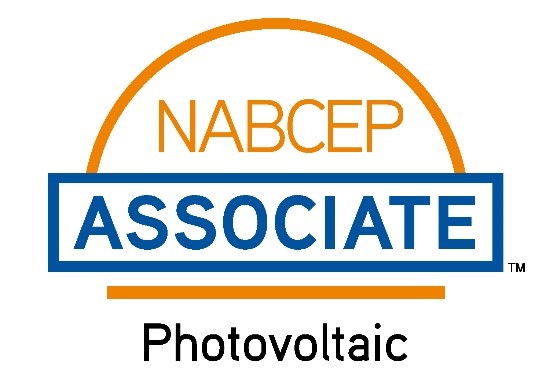
Our Proposal
As NABCEP Certified Professionals, we have access to the latest technology. And we have several agreements with industry leaders, such as
- HeliaSol (Germany) - OPV solar film watch video
- University of NewCastle (Australia) - Ultra-Thin Solar Panels watch video
- Vortex Bladeless (Spain)- Vortex Wind generators watch video
- Sea Wave Energy Ltd (UK) - SWEL watch video
- Ocean-Energy Technology OPT (US) - PB3 PowerBouy watch video
- Orbital Marine Power (UK) - Orbital O2 watch video
- Seaformatics (Canada) - WaterLily watch video
- Nering industries (Canada) - Poncelet wheel watch video
- Energy Technologies inc. (Canada) - Waterotor watch video
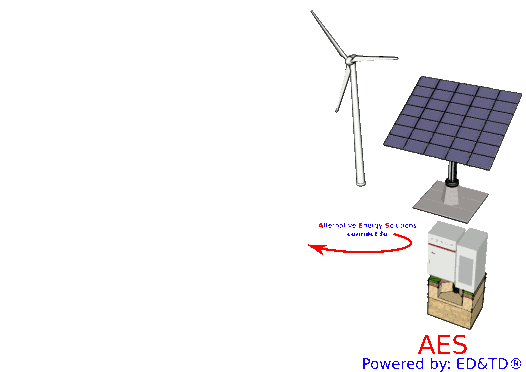
Well, as an engineering company in Electronic Design and Technological Development - ED&TD®, our particular goal is to provide an alternative to the conventional energy supply for each of your devices and, why not, for your entire company, office, industry and/or farm. In this context, there are several applications that can be given to our Power Generation with Renewable Energies - PGRE - Solutions, namely
- Water pumping systems from deep wells
- Aquaponic crops
- Powering motors such as Motor pumps, among others
- Water pumping systems from surface wells
- Electric fences
- Irrigation for conventional and/or hydroponic crops
- Powering a home, office or business
- Lighting of common areas and/or sports facilities
- Interconnection to the national grid by injecting excess energy
- And an infinite number of other applications requiring electrical energy …
We can provide to you all engineering that you requeire to make your idea(s), only contact us now!...
Our Customers Comments
If you are our customer, be the first to comment.
Write A Comment or Request An Appointment For Check Your Next Renewal Energy Project According Your Needs...